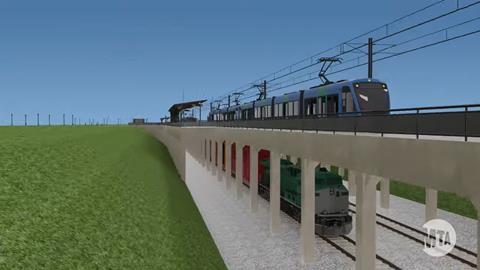
USA: New York Governor Kathy Hochul backed proposals to introduce light rail services in the Bay Ridge freight corridor serving Brooklyn and Queens in her State of the State Address in early January, when the Metropolitan Transportation Authority confirmed that light rail is the chosen mode.
The Interborough Express -branded light rail services are envisaged to operate over a 22·5 km route between Bay Ridge in Brooklyn and Jackson Heights in Queens. The existing freight line links docks at 65th Street Yard, which is served by a train ferry across the Hudson River, with short line operator New York & Atlantic Railway’s main marshalling yard at Fresh Pond in Queens; it then turns north to reach Jackson Heights.
Currently, the corridor between Bay Ridge and Fresh Pond is owned by MTA’s Long Island Rail Road commuter rail agency, while the 5 km north of Fresh Pond Yard is owned by Class I freight railway CSX as part of its Fremont Secondary. NY&A is the main user of the line; the last passenger trains ran in the early 1920s, according to MTA.
Avoiding Manhattan
Rapid population growth in suburban New York City in recent decades has pushed the subject of improved rail links between the outer boroughs higher up the agenda of local policymakers.
The Subway remains heavily orientated towards moving passengers to and from Manhattan, but the number of people living in Queens and Brooklyn is more than three times greater than the population of the city centre. Only one Subway line, the G, links Brooklyn and Queens without running into Manhattan.
The Interborough Express would provide interchange with up to 17 Subway lines and LIRR services, with end-to-end journey times expected to be around 40 min. Daily weekday ridership is estimated at 115 000.

Proposals to introduce passenger services in the corridor have been regularly put forward since the 1990s, when the first ideas were developed by the Regional Plan Association infrastructure advocacy group.
RPA had suggested that passenger services should run over the full length of the CSX route north of Jackson Heights to meet Amtrak’s Northeast Corridor near the Hell Gate Bridge. However, in early January MTA finally dismissed this idea, citing the emergence of the Penn Station Access project, which will see Metro-North commuter rail services introduced over the Hell Gate line to serve local communities in the Bronx.
Light rail chosen
According to MTA, the light rail option would use much of the existing rail infrastructure, meaning the Interborough Express ‘could be built more quickly and efficiently’. Alternatives using conventional rail technology or bus rapid transit have been ruled out.
Light rail would ‘preserve the Bay Ridge branch’s use as a freight line, providing an opportunity to connect to the New York New Jersey Port Authority’s Cross-Harbor Freight Project’, which could see a tunnel under the Hudson River replace the existing rail wagon barge float.
However, a YouTube video published by MTA in May 2022 indicated that the proposed light rail infrastructure would at least partially be built on concrete viaducts and guideways above the existing tracks, rather than sharing the right of way using tram-train technology or deploying temporal separation, as used by the diesel-powered River Line in New Jersey.
In explaining its choice, MTA said that ‘smaller, more flexible’ light rail vehicles would fit within the constraints of the existing corridor, and they can be ‘procured off the shelf without modification and draw on a different pool of potential suppliers than traditional MTA rolling stock’.
Responding to Governor Hochul’s address, MTA Chair Janno Lieber said that ‘moving forward with light rail for the Interborough Express means better access to jobs, education and economic opportunities for some 900 000 New Yorkers in Queens and Brooklyn’.
The cost of the project is expected to be around $5·5bn, but it is unclear how this would be funded. MTA continues to face a significant shortfall in farebox revenue as ridership across its bus and rail networks remains below pre-pandemic levels.
‘Governor Hochul is committed to working with MTA leadership, legislative partners, the city of New York, the federal government, and other critical stakeholders on a comprehensive set of solutions to the structural challenges facing MTA in order to put the authority on sound fiscal footing for many years to come’, says the formal State of the State book accompanying the gubernatorial address.
The environmental review process for the Interborough Express ‘will continue in 2023 and beyond’, MTA said.
Supporting documents
Click link to download and view these filesInterborough Express fact sheet - New York MTA
PDF, Size 1.17 mb

















